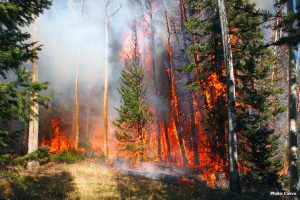by Alana Coulombe, Education programs administrator
Canadians have experienced a devastating start to spring this year, with almost every province and territory being upturned by wildfires. Emergency Preparedness Minister Bill Blair recently announced nearly 440 fires have burned 3.9 million hectares of forest which is more than 13 times the 10-year average for this time of year (The Canadian Press, 2023).
Wildfires can sometimes be a natural part of the ecosystem that contribute to forest diversity and health. For example, fire is a vital ecological component driving forest dynamics and the movement of wildlife populations. The diversity of Canada’s forest and grassland communities was largely influenced by numerous wildfires over a long period of time. The structure and growth of different species varies in response to fires of different frequencies, sizes, intensities, shapes, and seasons of burn.
Although wildfires can enhance ecological conditions in maintaining healthy forests, they can also pose numerous threats resulting in costly losses. Over the past decade, fire management costs in Canada have ranged from about $800 million to $1.5 billion a year (Natural Resources Canada, 2023). Forest management agencies evaluate each fire to balance ecological benefits while limiting potential damages and costs.
In many regions of Canada, wildfire season occurs between early April and late October. Hundreds of wildfires, varying in size and severity, may exist at one time. Wildfires are often started by lightning strikes or human activities such as fireworks or uncontrolled bonfires. Interestingly, lightning causes about 50% of all wildfires while accounting for about 85% of the annual area burned (Natural Resources Canada, n.d.). According to Natural Resources Canada, about 7,300 forest fires have occurred in Canada each year since 1990, burning an average of 2.5 million hectares annually. Although only 3% of wildfires that start in Canada consume more than 200 hectares in area, these fires account for 97% of the total area burned across the country each year.

Wildfires impact Canada’s freshwater sources both directly and indirectly. Forests absorb rain and provide a natural filtration process for replenishing surface water and groundwater sources. When forests are impacted by wildfires, the loss of vegetation inhibits this process and disturbs the water cycle which, in turn, can affect the amount and quality of freshwater available. Following a wildfire, rainwater carries ash, sediment, debris, nutrients, and other contaminants with it into lakes and reservoirs, occasionally contaminating drinking water sources. Chemicals in the ashes of human-made materials can also find their way into reservoirs and lakes, raising serious health and ecological issues including impaired human cardiovascular functioning and increased algal blooms in recreational water bodies.
Although many waterfront properties are in regions prone to wildfires, you can make your property wildfire resilient without sacrificing shoreline stability, water quality, or wildlife habitat. Plant native deciduous trees, shrubs, and wildflowers as a fire-resistant option for maintaining your shoreline buffer, as grasses and evergreen shrubs tend to be more flammable. You can find suitable native species for your region by using the free, Canada-wide Native Plant Database from Watersheds Canada’s Natural Edge Program.
Consider enhancing your wildfire resilience to help mitigate risks and protect fluctuating water quality under wildfires and other climate change impacts. Check out this infographic by Watersheds Canada for more ways to prepare for Canada’s wildfire season by preventing the spread of fire and minimizing property loss.
Additional Resources
Climate Atlas of Canada. (n.d.). Wildfires, water, and our health. https://climateatlas.ca/wildfires-water-and-our-health
Natural Resources Canada. (n.d.). Canadian National Fire Database (CNFDB). Government of Canada. https://cwfis.cfs.nrcan.gc.ca/ha/nfdb
Natural Resources Canada. (2023, June 7). Forest fires. Government of Canada. https://natural-resources.canada.ca/our-natural-resources/forests/wildland-fires-insects-disturbances/forest-fires/13143
The Canadian Press. (2023, June 13). Canada is experiencing its ‘worst wildfire season of the 21st century’: Blair. CTV News. https://www.ctvnews.ca/canada/canada-is-experiencing-its-worst-wildfire-season-of-the-21st-century-blair-1.6438723
